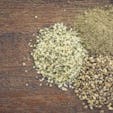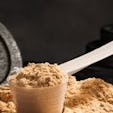Usually, when you hear “rice,” you think of carbs, not protein. But there’s enough protein in those little grains for anyone (vegetarian or otherwise) to boost lean muscle and strength.
Believe it or not, rice protein powder can deliver the same gains as whey, when taken in adequate amounts and complemented with other high-quality foods. In addition, rice protein is allergen- and gluten-free, easy to digest, and Earth-friendly.
The Complete Guide To Rice Protein Powder
If you’ve been avoiding rice products because you think of them as “carb foods,” it’s time you tapped into the power of rice protein.
What is Rice Protein?

Despite its rep as a carb source, rice contains a fair amount of protein—around four grams per cup of white rice, and more than five grams per cup of brown rice. Because brown rice offers slightly more protein, most rice protein supplements are derived from it. Rice protein powder is made by grinding up rice grains and treating them with an enzyme that separates the starch (carbohydrate) from the protein.
Rice protein is considered a medium-digesting protein. It absorbs more slowly than whey (which is the speediest one on the market), but it’s faster than casein (the slowest-digesting protein).
Rice protein is not technically a complete protein, but, as we’ll discuss below, it contains enough of the nine essential amino acids (EAAs) to be a great plant-based muscle-builder regardless.
What are the Benefits of Rice Protein?
Because it’s plant-based, rice protein is a viable supplement option for vegetarians and vegans who don’t want to look like your stereotypical vegetarian or vegan (just kidding!). But even carnivores can appreciate rice protein’s various benefits.
Helps Build Muscle

It’s a common perception that plant-based proteins don’t support muscle and strength gains like dairy, egg, and meat sources do, but science suggests otherwise. A 2018 study had MMA fighters split into two groups and supplement with either rice protein or whey to determine the effect. After six weeks, both groups had gained muscle and lost fat, with no discernible difference between them.
“Plant proteins are usually absorbed slower than whey protein due to their composition of more complex carbohydrate structures,” Says Ralf Jaeger, Ph.D., co-founder of the food, beverage, and supplement consulting firm Increnovo, and a co-author on multiple rice protein studies. “However, leucine, the most important amino acid for muscle building, is actually absorbed faster from rice than from whey.” (To be clear, when you take rice protein, you’re getting mostly protein, but, as with whey concentrate powders, there are usually three to four grams of carbs per serving as well.)
No Allergens, No Gluten
Individuals with allergies or sensitivities to soy, lactose, eggs, nuts, and gluten have nothing to worry about with rice protein.
Sustainable and Easy on the Environment
It takes fewer natural resources to produce rice protein than dairy proteins like whey and casein, and growing rice emits less carbon than raising cattle.
Digests Easily
Consuming rice protein usually does not result in bloating, cramping, or other gastric discomfort (many people can’t say the same about whey). According to research in Food Chemistry, rice protein is easier to digest than whey.
To get a little more technical, rice protein has greater than 90% digestibility and a relatively high bioavailability (how much of the protein is actually utilized by the body). For perspective, its ratings compare favorably to soy protein and are on par with pea protein, but rice protein isn’t quite as bioavailable as whey.
Is Rice Protein a Complete Protein?
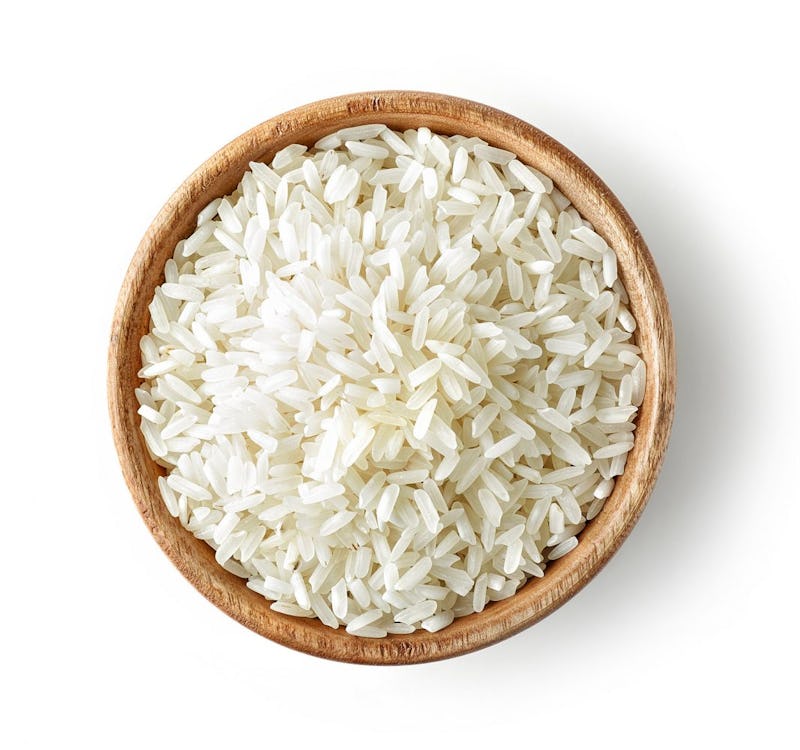
Technically, rice protein does not meet the criteria to be considered complete (and neither does hemp or pea protein, FYI). To be complete, a protein must not only contain all nine EAAs (tryptophan, threonine, isoleucine, leucine, lysine, methionine+cystine, phenylalanine+tyrosine, valine, and histidine), but also offer them in adequate amounts. Animal-derived proteins such as whey, egg, and beef have all of these aminos, and in large amounts, so they get more glory than their plant-based alternatives.
With that said, rice protein isn’t too far off the mark. It provides all of the EAAs, but falls short on lysine. The adequate amount here is 51 mg/g of protein, and rice protein contains only 31 mg/g. Lysine plays a vital role in supporting calcium production, aiding fatty acid metabolism, maintaining healthy cholesterol levels, and the nurturing of connective tissues like tendons and cartilage, so it’s certainly an important amino acid to consume. Fortunately, lysine can be found in a number of other commonly-eaten foods, including red meat, pork, poultry, cheese, cod, eggs, soybeans, tofu, spirulina, and fenugreek seed.
Lysine is also found in sufficient levels (71 mg/g) in another popular plant-based protein powder: pea protein (see our guide to pea protein HERE for more info). Interestingly, pea protein misses complete protein status by being low in only one amino acid also—methionine+cystine. Therefore, if you combine rice and pea proteins (as many plant-based protein supplements do), you’ll get all nine EAAs in adequate amounts.
Rice Protein vs. Whey
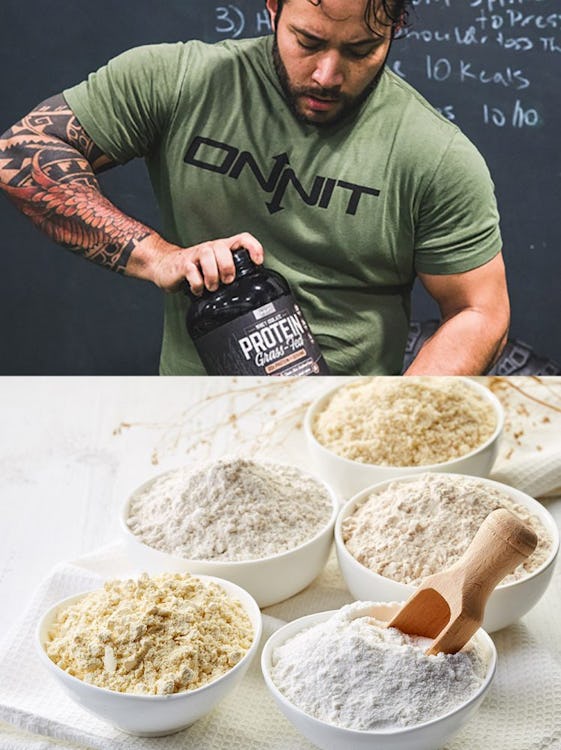
In a head-to-head comparison between rice protein and whey, most muscleheads would expect whey to win in a landslide—but it doesn’t.
As discussed in our guide to pea protein article, when looking for a protein powder to help stimulate muscle protein synthesis—and, as a result, drive muscle recovery and growth—there’s one amino acid, in particular, you need to focus on: leucine. It’s one of the three branched-chain amino acids (BCAAs), but more specifically, it’s the only one that’s been found to stimulate muscle growth on its own.
Whey contains more leucine than any other protein source, at 104 mg/g of protein. (Adequate leucine levels for complete proteins are 55 mg/g and up.) That’s why whey is widely considered the best protein for building muscle. But with that said, rice protein contains plenty of leucine in its own right, at 80 mg/g. And while it will never match the leucine content of whey, if you take in a sufficient amount of protein in your diet overall, it probably doesn’t matter. Why? Because once you reach a certain amount of leucine (achieved with only 1–2 scoops of virtually any protein powder), getting more of it provides no additional benefit.
Here’s what the science tells us¦
It takes 0.7–3 grams of leucine per serving of a protein source to stimulate muscle growth. Take in less than 0.7, and you risk leaving gains on the table, but consuming more than 3 appears to be overkill (not harmful, but produces no additional results). Coming in at the top end of that range takes right around two scoops of rice protein, or a little less than two scoops of whey.
So while whey does the job a bit more efficiently than rice protein, if you take two scoops of a rice protein supp post-workout, you can feel confident that you’re giving your body enough leucine to make the most of the session.
Research bears this out, specifically a 2013 Nutrition Journal study, co-authored by Jaeger. In the experiment, subjects consumed either 48 grams of rice protein or 48 grams of whey post-workout for eight weeks while following a standardized three days per-week resistance-training program. (Forty-eight grams represents right around two scoops of protein powder, or slightly more, as most products deliver 20 grams or so per scoop.)
Results showed that subjects in the rice and whey protein groups experienced equally positive gains in muscle thickness, body composition, and upper- and lower-body strength.
The study shows that rice protein can be on par with whey, but it also begs the question: can you still build muscle with less rice protein—say, one scoop of rice protein instead of two? As the amount of leucine in rice is less, would taking in less rice protein cost you gains?
Jaeger responds: “Twenty-one grams of rice protein would allow you to hit the minimum leucine threshold, and half of what we used in our study [24 grams] should get you there. We’re actually running exactly that study right now: 24 grams of rice protein versus 24 grams of whey. When we did the original study, plant proteins were generally considered to be not as effective for muscle protein synthesis, and we picked a dose that would safely put us over the max of the leucine threshold for both protein sources—that’s why we picked 48 grams.”
If you want to be certain you’re doing all you can for muscle growth, aim for two scoops of rice protein to be sure it loads you up with as much leucine as whey.
Does Rice Protein Cause Bloating?
Many people complain that whey protein makes them feel bloated and gassy, but we haven’t found any such criticism of rice protein supplements. This is likely due to the fact that nearly all of the fiber is stripped from the rice when the starch is separated from the protein during processing. Rice is also a hypoallergenic food.
Is Rice Protein Good for Weight Loss?
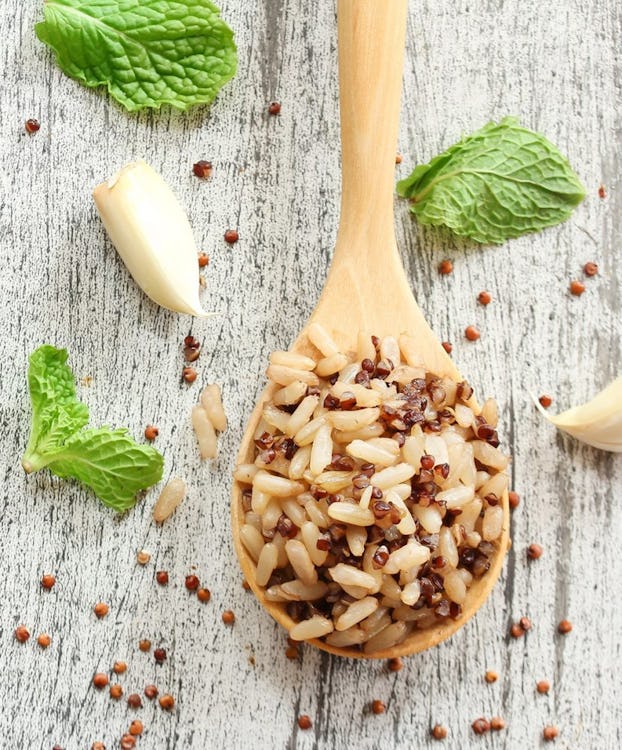
Research looking specifically at rice protein’s effectiveness for weight loss is limited, but the 2013 study referenced above found that subjects taking rice protein experienced the same fat loss as those taking whey.
Consistent protein intake in general has been linked to fat loss in numerous studies. High-protein foods tend to make you feel fuller than high-carb foods, and so they can help to control appetite and lead to a lower daily calorie intake.
This seems to hold true whether the protein is plant- or animal-based. One 2015 study in the American Journal of Clinical Nutrition showed comparable weight loss results in overweight subjects following diets high in either plant proteins or animal sources.
“Overall, protein is beneficial in increasing and maintaining weight loss due to effects on appetite regulation and energy expenditure,” says Jaeger. “It has been speculated that slow-release proteins have greater satiating effects [due to a steady release of amino acids]; however, data on this is inconclusive. This theory would favor rice over whey, as rice is more slowly digested than whey. In addition, the complex carbohydrates in rice should have a greater satiating effect than the simple sugars in whey [lactose]. Either way, I would expect rice protein to be as effective as animal proteins to support weight management.”
How Does Rice Protein Taste?
Better than you’d think. As with whey products, rice protein powders come in a variety of appealing flavors, from vanilla to chocolate to strawberry. Rice protein is slightly sweet and mixes easily in liquids. That said, many people describe its consistency as “chalky.” If possible, purchase individual (one-serving) samples initially instead of an entire container, so you can test the flavor before you invest in a big tub of it.
You can also mix rice protein into a smoothie with other ingredients you enjoy that can mask the powder’s flavor. Almond or coconut milk, fruit, peanut butter, and cocoa can all help cut a chalky taste and offer other nutritional benefits.
Who Should Take Rice Protein?
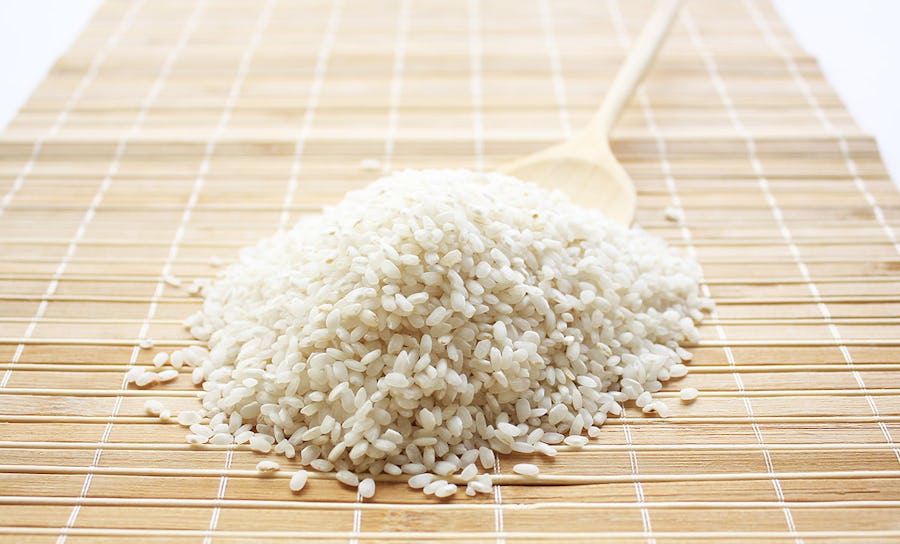
Vegetarians, vegans and anyone steering clear of dairy for any reason will want to consider rice protein in lieu of whey or casein. This holds whether you’re trying to support muscle and strength gains or just boost your overall protein intake for weight loss or health. Rice protein can be taken throughout the day just like any other protein powder. Mix a scoop into the liquid of your choice and take it with meals, or as a meal-replacement.
Which Rice Has the Most Protein?
Technically, brown rice contains slightly more protein than white rice, and most rice protein powders are made from brown rice. According to Jaeger, though, there’s no need to discriminate between white and brown. “The type of rice doesn’t matter,” he says, “as all same-source proteins will have similar amino acid profiles.”
What to Look for in a Rice Protein Product
When shopping for rice protein, you have the option of going with either a pure rice protein product, where rice is the only protein source, or a plant-based blend, where rice is one of multiple protein sources. Blends often contain pea and hemp protein in addition to rice.
The benefit of a protein blend is that you get a more diverse amino acid profile. This would mean that you’ll get more lysine, the one EAA that’s lacking in rice protein but isn’t in, say, pea protein. But, as mentioned earlier, lysine is found in a host of other foods, so you don’t absolutely have to make sure your protein supplement covers it.
“I personally would be looking for either straight-up rice protein or for a rice/pea protein blend,” says Jaeger, but he recommends looking for one that tastes good to you and dissolves easily.

)


